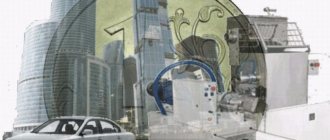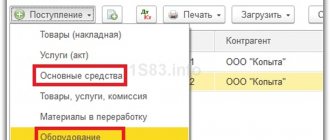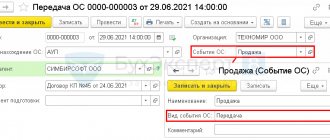Fixed assets in budget accounting - 2020-2021: introductory information
In accordance with paragraph 21 of Order No. 157n, the concept of “budget accounting of fixed assets” applies only to certain government organizations.
For example, government institutions, government agencies, extra-budgetary funds. In addition to the unified chart of accounts, a special chart of accounts must be used in budget accounting (Order of the Ministry of Finance of Russia dated December 6, 2010 No. 162n). The remaining government institutions, maintaining accounting and tax accounting of fixed assets in 2020-2021, in addition to the unified chart of accounts, use charts of accounts approved by order of the Ministry of Finance of Russia dated December 16, 2010 No. 174n or dated December 23, 2010 No. 183n (depending on the type of organization) and others regulations.
For example, FSBU “Fixed assets”, approved. by order of the Ministry of Finance of Russia dated December 31, 2016 No. 257. ConsultantPlus experts explained what institutions should take into account when applying this standard. Get trial demo access to the K+ system and study the review material for free.
Read about the regulatory documents governing accounting in budgetary structures here.
In this article we will refer to orders No. 157n and 162n as the basis for budget accounting. From the beginning of 2021, public sector organizations must be guided by the new federal standard “Fixed Assets”, approved. by order of the Ministry of Finance dated December 31, 2016 No. 257n (hereinafter referred to as the Standard). These documents reveal the general principles of accounting for fixed assets, as well as the logic of making transactions.
According to clause 8 of the Standard, in order to classify an asset as a fixed asset, the following criteria must be met:
- Property (with the exception of periodicals that make up the library collection of the subject of accounting) is classified as fixed assets regardless of its useful life.
- The accounting entity predicts the receipt of economic benefits or useful potential from the use of the asset.
- The initial cost of property as an accounting object can be reliably estimated.
If an asset does not meet at least one of the above criteria, it is recorded in off-balance sheet accounts. Information about such material assets is disclosed in the financial statements.
NOTE! Fixed assets do not include objects classified as inventories in accordance with clause 99 of Order No. 157n. For example, fishing gear, gas-powered saws, etc.
Each inventory item as a unit of accounting for fixed assets must be assigned a number. And an inventory card is created for each object.
To account for fixed assets, a synthetic account 010100000 “Fixed Assets” is provided. The budget accounting account number consists of 26 digits, and only 18–26 digits are used in the accounting of the institution. Depending on the group and type of fixed assets, as well as the essence of their movement, the code in the 22–26 digits changes in the account number.
Below we consider the scheme for generating an accounting account number in a budgetary organization, and also decipher the category codes using an example. A detailed explanation of the categories can also be found in clause 21 of the instructions to the chart of accounts (order No. 157n), in the table of the budget accounting chart of accounts and in clause 2 of the instructions to it (order No. 162n).
| Account digit number | ||||
| 18 | 19-21 | 22 | 23 | 24-26 |
| Financial support | Accounting object | Accounting object group | Type of accounting object | Type of receipts, disposals of an accounting object |
| Example: account 110118310 “Increase in the value of other fixed assets - real estate of the institution” | ||||
| 1 | 101 | 1 | 8 | 310 |
| 1 - at the expense of the budget | 101—fixed assets | 1—real estate | 8 - other fixed assets | 310 - increase in OS cost |
Read about creating a working chart of accounts in a budget organization here .
Note that for budget accounting of fixed assets, according to Order No. 162n, only 2 types of financial support are possible: at the expense of the budget (code 1) and funds at temporary disposal (code 3).
Thus, government institutions, government agencies and other organizations falling under the jurisdiction of Order No. 162n cannot have their own non-budgetary income.
Features of budget accounting of treasury property: legal framework and accounts used
In relation to the norms of Art. 5 Federal Law of the Russian Federation No. 402 (“On Accounting”), property objects of the state treasury of the Russian Federation, as well as constituent entities and municipalities, are recognized as objects of accounting. Its organization is based on an order that essentially defines two Instructions for Use:
- Unified chart of accounts for government agencies (introduced by Order of the Ministry of Finance of the Russian Federation No. 157n dated December 1, 2010).
- Chart of accounts for budget accounting (introduced by Order of the Ministry of Finance of the Russian Federation No. 162n dated December 6, 2010).
In everyday life they are called this: Instruction No. 157n or, respectively, No. 162n. Guided by their provisions, accounting reflects the necessary changes in the composition and all characteristics of objects using accounts. 0 108 00 000 “NFA of treasury property”. Some examples are shown below in the table (according to treasury NFA).
| Real Estate Property | Movement property | Precious metals | ON | NPA | MOH |
| 0 108 51 000 | 0 108 52 000 | 0 108 53 000 | 0 108 54 000 | 0 108 55 000 | 0 108 56 000 |
So, non-financial assets (NFAs) are displayed without inventory (as well as analytical) accounting in monetary terms. It should be taken into account that the information in the accounting registers for objects as of a specific monthly reporting date must properly correspond to the information in the relevant register.
Accounting for fixed assets upon admission to budgetary institutions
OS are received by institutions at actual cost, which includes (clause 15 of the Standard):
- cost paid to the supplier;
- the cost of construction work when creating the facility;
- the cost of all costs required to create the OS;
- fare;
- amounts for related services;
- customs duties;
- as well as other costs associated with the purchase/creation of the OS.
NOTE! If the fixed asset will be used in budgetary activities, then the amount of input VAT is included in the initial cost.
The receipt of fixed assets is reflected in the synthetic account 0010600000 “Investments in non-financial assets”, which contains 3 grouping accounts:
- 0010611000 - for real estate;
- 0010631000 - for movable;
- 0010641000 - for accounting for financial lease objects.
In the accounting of fixed assets, to reflect receipts, separate analytical accounts are allocated, in 24–26 digits of which code 310 is used for each type of fixed assets (see the chart of accounts approved by Order No. 162n). This code indicates an increase in the cost of the OS.
The main entries for accounting for fixed assets upon receipt are shown in the table below. Other transactions can be found in paragraphs. 7, 31, 33, 34 instructions to the chart of accounts (order No. 162n).
| Wiring | Description of posting in fixed asset accounting |
| Dt 010600000 “Investments in non-financial assets” (010611310, 010631310, 010641310) Kt 020800000 “Settlements with accountable persons” (020831660, 020832660), 030200000 “Settlements for accepted obligations” (030231730, 030232730) | Purchasing an OS |
| Dt 010600000 “Investments in non-financial assets” (010611310, 010631310) Kt 030200000 “Settlements for accepted obligations”, 020800000 “Settlements with accountable persons”, 010400000 “Depreciation”, 030300000 “Settlements for payments to budgets”, 010500000 “Inventories” | Creating an OS object yourself |
| Dt 010100000 “Fixed assets” (010111310, 010112310, 010113310) Kt 010611310 “Increasing investments in fixed assets - real estate of the institution” | Commissioning of the constructed building |
| Dt 010100000 “Fixed assets” (010111310–010113310, 010115310, 010118310, 010131310–010138310) Kt 010611310 “Increase in investments in fixed assets - real estate of the institution”, 010631310 “Increase in investments in fixed assets - other movable property of the institution” | Commissioning of purchased, manufactured household goods. OS way |
| Dt 010100000 “Fixed assets” (010111310–010113310, 010115310, 010118310, 010131310–010138310) Kt 030404310 “Internal settlements for the acquisition of fixed assets” | The OS object was received from another budget institution that has the same budget resource manager |
| Dt 010100000 “Fixed assets” (010111310–010113310, 010115310, 010118310, 010131310–010138310) Kt 040110180 “Other income” | The OS object was received from another budgetary institution that has a different manager of budget resources at the same level, from organizations, individuals. |
| Dt 010100000 “Fixed assets” (010111310–010113310, 010115310, 010118310, 010131310–010138310) Kt 040110100 “Income of an economic entity” (040110151, 040110152, 040110153) | Other gratuitous receipts of fixed assets |
| Dt 010140000 “Fixed assets - leased items” (010141310–010148310) Kt 010641310 “Increasing investments in fixed assets - leased items” | Acceptance for registration in 2016–2018. OS leased |
For information on how the accounting policy of a budgetary institution is formed, read the material “An example of an accounting policy in a budgetary institution (nuances).”
Depreciation of fixed assets in 1C: Accounting of a government institution 8
Published 02/15/2016 16:42 In this article I want to talk about the accrual, additional accrual and change of depreciation parameters of fixed assets in the 1C program: Accounting of a government institution 8th edition 1.0. Depreciation is the gradual decrease in the value of property due to wear and tear. At the same time, there are several ways to calculate depreciation: this is a 100% accrual upon commissioning of a fixed asset costing 3,000 rubles or more. up to 40,000 rub. and the linear method - for fixed assets worth over 40,000 rubles.
I would like to once again draw your attention to the fact that in order to correctly calculate depreciation, you must correctly indicate the OKOF code in the document “Acceptance for accounting of fixed assets and intangible assets.” I talked about this in detail in the article Purchase and acceptance for accounting of fixed assets in the 1C program: Accounting of a government institution 8 edition 1.0.
To check the parameters for calculating depreciation, go to the fixed asset card on the “Depreciation” tab.
If any of the parameters need to be changed, then for this you need to use the special document “Changing depreciation parameters”, which is located in the menu “OS, intangible assets, legal acts” - “Working with registers of information on OS”.
We create a new document and fill in the fields, while changing the necessary parameters.
After filling out the document, save and post it. Now, from the date specified in the document, depreciation will be calculated according to the new parameters.
To change the cost account when calculating depreciation, there is a special document “Changing the cost account for calculating depreciation of fixed assets”, located in the same menu.
Let's create a new document.
It is possible to automatically fill out the tabular part of the document for the accounting account.
And then you can automatically change the KPI for depreciation.
You can also change the cost account automatically.
After filling out the document, save and post it. Changes will take effect from the date of the document.
The depreciation calculation itself must be done monthly, on the last day of the month. To do this, we use the document “Calculation of depreciation of fixed assets and intangible assets.”
We create a new document, click the “Fill” button, fill it out and post it.
From the document you can print the “Statement of Accrued Depreciation”.
There are cases when it is necessary to suspend or resume depreciation. The document “Suspension of depreciation accrual” is intended for these purposes. It is used to suspend the calculation of depreciation when transferring a fixed asset to conservation for a period of more than three months and to resume the calculation of depreciation after re-preservation.
Let's create a new document. The document presents several operations to choose from.
Select the desired operation and fill out the table section. After filling out the document, we submit it.
Sometimes there are still cases when adjustments to accrued depreciation are necessary. For example, the calculated amount of depreciation and the balance of account 104 for the object diverge, or it is necessary to accrue additional depreciation to 100% of the book value for fixed assets (intangible assets), for which the depreciation calculation method is “100% upon commissioning”.
To do this, use the document “Adjustment of Depreciation”.
We create a new document, which also provides the ability to automatically fill in the accounting account. The adjustment is carried out automatically.
If you need more information about working in 1C: BGU 8, then you can get our collection of articles for free using the link.
Author of the article: Natalya Stakhneva
Consultant on 1C programs for government agencies
Did you like the article? Subscribe to the newsletter for new materials
Add a comment
Comments
0 Irina17 12/02/2016 14:27 Good afternoon! Tell me how to split group OS accounting into individual ones in the program?
Quote
Update list of comments
JComments
Depreciation of fixed assets
Government institutions charge depreciation of fixed assets linearly over their service life. There is also a rule of monthly accruals in the amount of 1/12 of the annual amount. Depreciation charges begin to be reflected in the month following the month the facility is put into operation.
Read about the practical application of the linear method in the article “Linear method of calculating depreciation of fixed assets (example, formula)” .
The useful life is determined based on:
- the expected period of receipt of economic benefits;
- recommendations contained in the manufacturer's documents;
- warranty period for use of the object;
- other methods described in clause 35 of the Standard
Depreciation is reflected in the synthetic account 010400000 “Depreciation”.
To record entries for depreciation charges, analytical accounts ending in 410 are used, which are used in the following transaction: Dt 040120271 “Depreciation costs of fixed assets and intangible assets”, 010900000 “Costs of manufacturing finished products, performing work, services” (010960271, 010970271 , 010980271, 010990271) Kt 010400000 “Depreciation” (010411410–010413410, 010415410, 010418410, 010431410–010438410).
To account for fixed assets leased: Dt 040120271 “Depreciation costs of fixed assets and intangible assets” Kt 010440000 “Depreciation of leased items” (010441410–010448410).
In paragraphs 19, 20 instructions to the chart of accounts (order No. 162n) consider special cases of reflecting depreciation, for example, for fixed assets received free of charge.
How is depreciation of fixed assets calculated?
According to paragraph 36 of the Standard “Fixed Assets,” depreciation of a fixed asset item is calculated in accordance with the accounting policy of the institution. There are three ways to calculate depreciation:
- Linear method - assumes uniform accrual of a constant amount of depreciation throughout the entire useful life of the asset;
- Declining balance method - the annual amount of depreciation is determined based on the residual value of the object at the beginning of the reporting year and the depreciation rate calculated based on the useful life of this object and the coefficient not exceeding 3, used by the accounting entity and established by it in accordance with its accounting policies;
- Rate-of-production method—Calculate depreciation based on the expected use or expected productivity of the asset. In accordance with this method, the amount of depreciation can be equal to zero during the stoppage of production of products using the corresponding fixed asset item.
Institutions, as a rule, choose the straight-line method of calculating depreciation. That is, based on the book value of the property and the depreciation rate calculated based on its useful life.
More on the topic: How to return the proceeds received to the cashier using a card in a budgetary (autonomous) institution?
Depreciation of fixed assets for real estate assets is calculated as follows:
- If the cost of an object is up to 100 thousand rubles inclusive, depreciation is accrued in the amount of 100% of the book value when the object is registered;
- If the cost of an object exceeds 100 thousand rubles, depreciation is calculated in accordance with the calculated depreciation rates.
For movable property:
- When the cost of an object of fixed assets is up to 10 thousand rubles inclusive, with the exception of library collection objects, depreciation is not accrued;
- If the cost of a library collection object is up to 100 thousand rubles inclusive, depreciation is charged at the rate of 100% of the original cost when it is put into operation;
- If the cost of a fixed asset is from 10 thousand rubles to 100 thousand rubles inclusive, depreciation is accrued in the amount of 100% of the original cost when it is put into operation.
Please note: if the useful life of the fixed asset has changed as a result of completion, reconstruction, additional equipment, modernization or partial liquidation, the amount of annual depreciation is calculated using a linear method based on the residual value of the fixed asset and the adjusted depreciation rate, depending on the remaining useful life. These indicators should be calculated on the date of change in the useful life of an asset, starting from the month in which this period was changed.
If, as a result of long-term operation, the residual value of the asset has reached zero, but according to the results of an inspection by the specialized commission, it is still suitable for use, then it does not need to be written off (clause 87 of Instruction No. 157n).
Accounting for disposal of fixed assets
To account for fixed assets upon their disposal, separate analytical accounts of the “Fixed Assets” account are also used, ending with 410 and indicating a decrease in the value of the corresponding fixed assets.
For a selection of practical recommendations for writing off certain types of fixed assets in the accounting of public sector employees, see the analytical review from ConsultantPlus experts. Get free demo access to K+ and go to the Ready Solution to find out all the details of this procedure. And in this publication you will find a sample order for writing off fixed assets in a budget institution.
The main entries for accounting for fixed assets upon disposal are shown in the table below. Other transactions can be found in clause 10 of the instructions for the chart of accounts (order No. 162n).
| Wiring | Description of posting in fixed asset accounting |
| Dt 040120271 “Costs for depreciation of fixed assets and intangible assets”, 010634340 “Increase in investments in inventories - other movable property of the institution”, 010900000 “Costs for the manufacture of finished products, performance of work, services” (010960271, 010970271, 010980271, 010 990271) Kt 010100000 “Fixed assets” (010134410, 010135410, 010136410, 010138410) | Commissioning of an OS costing no more than 3,000 rubles. |
| Dt 030404310 “Internal settlements for the acquisition of fixed assets”, 040120200 “Expenses of an economic entity” (040120241, 040120242, 040120251, 040120252, 040120253) Kt 010100000 “Fixed assets” (010111410–010113410, 010115410, 010118410, 010131410–010138410) | Free transfer of an object or transfer to trust management |
| Dt 010400000 “Depreciation” (010411410–010413410, 010415410, 010418410, 010431410–010438410) Kt 010100000 “Fixed assets” (010111410–010113410, 010115410, 010118410, 010131410–010138410) Dt 040110172 “Income from operations with assets” Kt 010100000 “Fixed assets” (010111410–010113410, 010115410, 010118410, 010131410–010138410) | OS sales |
Results
Budgetary accounting of fixed assets has a complex structure of accounts and their coding.
However, the instructions listed in the article contain detailed explanations and lists of possible entries that can help the accountant. Maintaining budgetary accounting of fixed assets is strictly regulated. All movements of fixed assets must be documented in primary documents and reflected in accounting by accounting entries. You can find more complete information on the topic in ConsultantPlus. Free trial access to the system for 2 days.







